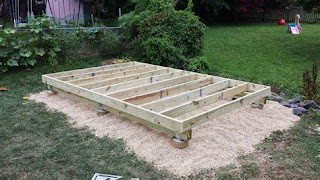When it comes to building a sturdy and reliable 8x10 lean-to shed, choosing the right materials for the walls and roof sheathing is crucial. Plywood is a popular and versatile choice that provides strength, durability, and ease of installation. Here's what you need to know about using plywood for the walls and roof sheathing of your shed.
Why Choose Plywood?
Plywood is a type of engineered wood that is made by bonding together multiple layers of thin wood veneers with adhesives, creating a strong and durable panel. This construction method results in a panel that is less prone to warping, splitting, and shrinking compared to solid wood, making it an ideal choice for construction projects like shed walls and roof sheathing.
Plywood is also known for its versatility, as it comes in various thicknesses, grades, and types, allowing you to choose the right plywood for your specific shed project. It is available in both exterior and interior grades, with exterior-grade plywood being suitable for outdoor applications due to its water resistance and ability to withstand the elements.
Another advantage of plywood is its ease of installation. It can be easily cut, nailed, and screwed, making it a popular choice for DIY shed builders. Additionally, plywood can be painted or stained to match your desired aesthetic, providing a polished and finished look to your shed.
Choosing Plywood for Walls and Roof Sheathing
When selecting plywood for your shed walls and roof sheathing, it's important to consider the following factors:
1. Thickness:
The thickness of the plywood you choose will depend on the load-bearing requirements of your shed. For walls, 1/2" or 5/8" plywood is usually sufficient, while for roof sheathing, 5/8" or 3/4" plywood is typically recommended. However, it's always a good idea to consult local building codes and regulations to ensure you choose the appropriate thickness for your specific location and shed design.
2. Grade:
Plywood comes in different grades, which determine its quality and suitability for various applications. For shed walls and roof sheathing, it's recommended to use exterior-grade plywood, as it is designed to withstand moisture and exposure to the elements. Exterior-grade plywood is typically labeled as "Exterior" or "Exposure 1" and is made with water-resistant adhesives that provide added durability and resistance to decay and rot.
3. Type:
Plywood is available in different types, such as CDX, BCX, and T1-11, each with its unique features and uses. CDX plywood is the most common type used for shed walls and roof sheathing, as it is affordable and provides good structural strength. BCX plywood is a higher-grade option that has a smoother surface and fewer knots, making it suitable for applications where appearance is a concern. T1-11 plywood is a type of siding plywood that has a textured surface and is commonly used for shed walls to provide a rustic look.
Installation Tips
When installing plywood for your shed walls and roof sheathing, consider the following tips:
1. Proper Fastening:
Use the appropriate fasteners, such as nails or screws, and follow the manufacturer's recommendations for spacing and placement. Make sure to fasten the plywood to the underlying framing, typically at 16-inch intervals for walls and 6-inch intervals for roof sheathing, to ensure proper structural support.
2. Sealing and Priming:
Before installation, seal the edges and ends of the plywood panels with a wood sealer or primer to protect them from moisture and prevent delamination. This step is especially important for exterior-grade plywood used in shed walls and roof sheathing, as it will help prolong the lifespan of the plywood and enhance its performance.
3. Proper Overlapping:
When installing plywood panels, make sure to overlap the seams properly to create a tight and secure fit. Follow the manufacturer's instructions for the recommended overlapping pattern, and ensure that the edges of the plywood panels are aligned and flush with each other to avoid gaps or uneven surfaces.
4. Ventilation:
Proper ventilation is essential for preventing moisture buildup inside the shed, which can lead to rot and decay of the plywood. Install vents or windows to allow for adequate airflow and moisture escape, especially in the roof area where condensation can occur.
5. Finishing:
After the plywood is installed, you may choose to paint or stain it to protect it from the elements and enhance its appearance. Follow the manufacturer's recommendations for the appropriate type of paint or stain for plywood, and apply it according to the instructions for the best results.
Conclusion
Plywood is a reliable and versatile material for building the walls and roof sheathing of your 8x10 lean-to shed. Its strength, durability, and ease of installation make it a popular choice among DIY shed builders. By choosing the right thickness, grade, and type of plywood, and following proper installation techniques, you can ensure a sturdy and long-lasting shed that will withstand the test of time.

0 comments:
Post a Comment
Note: Only a member of this blog may post a comment.